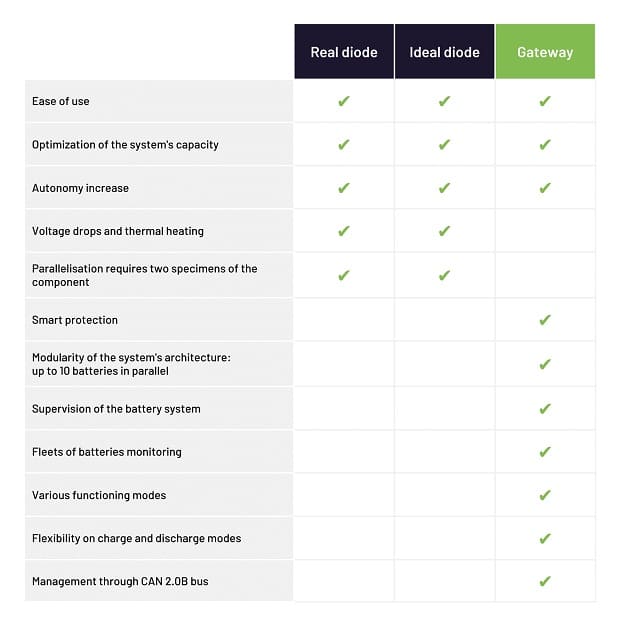Let's get in touch
A project you want to discuss about? Need more information? Want to know more about our sustainable and modular lithium batteries solutions?
Nowadays, there are many types of energy systems allowing to power all kinds of applications. These systems are more and more powerful to answer increasing energetics needs, notably by means of lithium batteries. However, in order to have a significant capacity to supply systems requiring an important amount of energy, batteries paralleling can turn out to be the perfect solution. Indeed, parallelize batteries means to considerably increase the application’s capacity and therefore its autonomy since its supply comes from several power sources linked to each other. Thus, it turns out to be an efficient solution to obtain more power by combining several batteries’ energetic potentials.
In order to parallelize lithium batteries, it is yet essential to use a technology configured for this purpose which will be added to the system. Otherwise, if batteries have different tensions, it will imply unlimited high currents going around the most charged battery to the least charged one, thus impacting their functioning. It will affect their management systems (BMS) which will switch on and block the batteries’ utilization. The appropriate paralleling solution must be found to avoid these problems.
In order to parallelize lithium batteries, there are various solutions each having their own advantages and disadvantages, starting with diodes. Indeed, real diodes have many positive points since it is an affordable solution easy to use. Another significant advantage is that they allow incomplete charges for low powers. However, it is necessary to have two diodes to work and allow the current to flow during charge and discharge phases since they proceed as one-sided switch. Moreover, they imply voltage drops and thermal heating besides not being fitted with any smart protection, which can be risky for the system’s parallelization.
Apart from real diodes, ideal diodes also represent an appropriate solution to connect lithium batteries in parallel. Even if they are more expensive than real diodes, they are just as simple to use and they imply moderated thermal heating. However, when it comes to voltage drops, they are insignificant comparing to real diodes’ ones. In addition to that, ideal diodes also require to work by pairs to let the current flow during charge and discharge phases. They don’t benefit from a smart protection either but they are still a simple and efficient solution, despite the fact they can’t monitor the whole battery system.
In order to offer you an effective solution for batteries paralleling, TYVA Energie’s Engineers of our Research Unit have developed the Gateway CAN technology. It is a component represented as a small electronic case which allows to connect several batteries in parallel together, but also to monitor fleets of batteries. Thanks to this tool, it is possible to obtain several information concerning the whole system such as SOH, SOC, IMD or IMR.
Like the entire TYVA Energie’s range, the Gateway CAN provides a certain modularity and flexibility to the system’s architecture since it allows to connect 10 batteries in parallel. Thus, it is fitted to power more consequent systems by optimizing the capacity available for various functioning modes. To this end, it supervises the insulation monitoring device and communicates with a smart charger to adjust the current according to the energy system’s number of batteries. It is possible to use more output power depending on the system status by continuously respecting IMD and IMR instructions.

Another benefit of the Gateway is to directly communicate with each battery through CAN bus which makes it independent regarding currents and voltages. As compared to diodes, it provides more flexibility on charge and discharge modes besides being fitted with a CAN 2.0B connection for its management and steering. This connection bus also allows to remotely control power and stop buttons (Ignition Key) of each battery. As a technology genuinely integrated at the heart of the system controlling its functioning, TYVA Energie’s Gateway CAN is designed to be the ideal management tool to connect batteries in parallel.
A project you want to discuss about? Need more information? Want to know more about our sustainable and modular lithium batteries solutions?
TYVA Energie
P.A. Marenton 3
11 rue des Sources, 07100 Annonay | France
+33 4 26 30 80 79
©2022 TYVA Energie